Birds
High-level taxonomy
Birds are categorised as a biological class, Aves. The
earliest known species of this class is Archaeopteryx
lithographica, from the Late Jurassic period. According to
the most recent consensus, Aves and a sister group, the
order Crocodilia, together form a group of unnamed rank, the
Archosauria.
Phylogenetically, Aves is usually defined as all descendants
of the most recent common ancestor of modern birds (or of a
specific modern bird species like Passer domesticus), and
Archaeopteryx. Modern phylogenies place birds in the
dinosaur clade Theropoda.
Modern birds are divided into two superorders, the
Paleognathae (mostly flightless birds like ostriches), and
the wildly diverse Neognathae, containing all other birds.
Bird orders
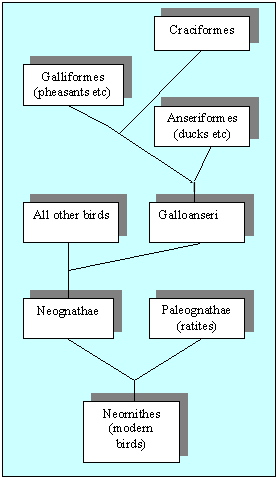
Relationships between bird orders according the
Sibley-Ahlquist taxonomy. "Galloanseri" is now
considered a superorder Galloanserae.
This is a list of the taxonomic orders in the class Aves.
The
list of birds gives a more detailed summary, including
families.
Paleognathae:
- Struthioniformes, Ostrich, emus, kiwis, and allies
Tinamiformes, tinamous
Neognathae:
- Anseriformes, waterfowl
Galliformes, fowl
Gaviiformes, loons
Podicipediformes, grebes
Procellariiformes, albatrosses, petrels, and allies
Sphenisciformes, penguins
Pelecaniformes, pelicans and allies
Ciconiiformes, storks and allies
Phoenicopteriformes, flamingos
Accipitriformes, eagles, hawks and allies
Falconiformes, falcons
Turniciformes, button-quail
Gruiformes, cranes and allies
Charadriiformes, gulls, plovers and allies
Pteroclidiformes, sandgrouse
Columbiformes, doves and pigeons
Psittaciformes, parrots and allies
Cuculiformes, cuckoos, turacos, hoatzin
Strigiformes, owls
Caprimulgiformes, nightjars and allies
Apodiformes, swifts
Trochiliformes, hummingbirds
Coraciiformes, kingfishers
Piciformes, woodpeckers and allies
Trogoniformes, trogons
Coliiformes, mousebirds
Passeriformes, passerines
Note: This is the traditional classification (the
so-called
Clements order). A more recent, radically different
classification based on molecular data has been developed
(the so-called Sibley-Monroe classification or Sibley-Ahlquist
taxonomy). This has influenced taxonomical thinking
considerably, with the Galloanserae proving well-supported
by recent molecular, fossil and anatomical evidence[citation needed].
With increasingly good evidence, it has become possible by
2006 to test the major proposals of the Sibley-Ahlquist
taxonomy. The results are often nothing short of astounding,
see e.g. Charadriiformes or Caprimulgiformes.
Extinct bird orders
A wide variety of bird groups became extinct during the
Mesozoic era and left no modern descendants. These include
the Order Archaeopterygiformes, Order Confuciusornithiformes,
toothed seabirds like the Hesperornithiformes and
Ichthyornithes, and the diverse Subclass Enantiornithes ("opposite birds").
For a complete listing of prehistoric bird groups, see
Fossil birds.
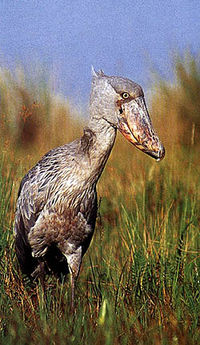
Shoebill, Balaeniceps rex
Evolution
There is
significant evidence that birds evolved from theropod
dinosaurs, specifically, that birds are members of
Maniraptora, a group of theropods which includes
dromaeosaurs and oviraptorids, among others.[1] As more
non-avian theropods that are closely related to birds are
discovered, the formerly clear distinction between non-birds
and birds becomes less so. Recent discoveries in northeast
China (Liaoning Province) demonstrating that many small
theropod dinosaurs had feathers contribute to this
ambiguity.
The basal bird Archaeopteryx, from the Jurassic, is
well-known as one of the first "missing links" to be found
in support of evolution in the late 19th century, though it
is not considered a direct ancestor of modern birds.
Confuciusornis is another early bird; it lived in the Early
Cretaceous. Both may be predated by Protoavis texensis,
though the fragmentary nature of this fossil leaves it open
to considerable doubt if this was a bird ancestor. Other
Mesozoic birds include the Enantiornithes, Yanornis,
Ichthyornis, Gansus and the Hesperornithiformes, a group of flightless divers
resembling
grebes and
loons.
The recently discovered dromaeosaur Cryptovolans was
capable of powered flight, possessed a sternal keel and had
ribs with uncinate processes. In fact, Cryptovolans makes a
better "bird" than Archaeopteryx which is missing some of
these modern bird features. Because of this, some
paleontologists have suggested that dromaeosaurs are actually basal birds whose larger
members are secondarily flightless, i.e. that dromaeosaurs
evolved from birds and not the other way around. Evidence
for this theory is currently inconclusive, but digs continue
to unearth fossils (especially in China) of the strange
feathered dromaeosaurs. At any rate, it is fairly certain
that avian flight existed in the mid-Jurassic and was "tried
out" in several lineages and variants by the mid-Cretaceous.
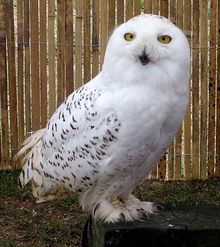
Snowy Owl, Bubo scandiacus
Although ornithischian (bird-hipped) dinosaurs share the
same hip structure as birds, birds actually originated from
the saurischian (lizard-hipped) dinosaurs (if the
dinosaurian origin theory is correct), and thus arrived at
their hip structure condition independently. In fact, the
bird-like hip structure also developed a third time among a
peculiar group of theropods, the Therizinosauridae.
An alternate theory to the dinosaurian origin of birds,
espoused by a few scientists (most notably Lary Martin and
Alan Feduccia), states that birds (including maniraptoran
"dinosaurs") evolved from early archosaurs like Longisquama,
a theory which is contested by most other scientists in
paleontology, and by experts in feather development and
evolution such as R.O. Prum. See the Longisquama article for more on this alternative.
Modern birds are classified in Neornithes, which are now
known to have evolved into some basic lineages by the end of
the Cretaceous. The Neornithes are split into the
Paleognathae and Neognathae. The paleognaths include the
tinamous (found only in Central and South America) and the
ratites. The ratites are large flightless birds, and include
ostriches, cassowaries, kiwis and emus (though some
scientists suspect that the ratites represent an artificial
grouping of birds which have independently lost the ability
to fly in a number of unrelated lineages). The basal
divergence from the remaining Neognathes was that of the
Galloanseri, the superorder containing the Anseriformes (ducks,
geese and
swans), and the
Galliformes (the
pheasants,
grouse, and their allies). See the chart for more
information.
The classification of birds is a contentious issue.
Sibley & Ahlquist's Phylogeny and Classification of
Birds (1990) is a landmark work on the classification of
birds (although frequently debated and constantly revised).
A preponderance of evidence seems to suggest that the modern
bird orders constitute accurate
taxa. However, scientists are not in agreement as to the
relationships between the orders; evidence from modern bird
anatomy, fossils and DNA have all been brought to bear on
the problem but no strong consensus has emerged. More
recently, new fossil and molecular evidence is providing an
increasingly clear picture of the evolution of modern bird
orders.
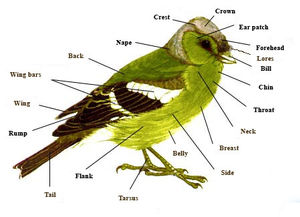
Anatomy of a typical bird
Bird anatomy
-
Birds have a
body plan that shows so many unusual adaptations (mostly
aiding
flight) that birds have earned their own unique class in
the vertebrate phylum.
Nesting
Eggs
All birds lay amniotic eggs[2] with hard shells made
mostly of calcium carbonate. Non-passerines typically have
white eggs, except in some ground-nesting groups such as the
Charadriiformes, sandgrouse and nightjars, where camouflage
is necessary, and some parasitic cuckoos which have to match
the passerine host's egg. Most passerines, in contrast, lay
coloured eggs, even if, like the tits they are hole-nesters.
The brown or red protoporphyrin markings on passerine
eggs reduce brittleness and are a substitute for calcium
when that element is in short supply. The colour of
individual eggs is genetically influenced, and appears to be
inherited through the mother only, suggesting that the gene
responsible for pigmentation is on the sex
determining W chromosome (female birds are WZ, males ZZ).
The eggs are laid in a nest, which may be anything from a
bare cliff ledge or ground scrape to elaboratey decorated
structures such as those of the oropendolas.
Social systems and parental care
The three mating systems that predominate among birds are
polyandry, polygyny, and monogamy. Monogamy is seen in
approximately 91% of all bird species. Polygyny constitutes
2% of all birds and polyandry is seen in less than 1%. Monogamous species of
males and females pair for the breeding season. In some
cases, the individuals may pair for life.
One reason for the high rate of monogamy among birds is
the fact that male birds are just as adept at parental care
as females. In most groups of animals, male parental care is
rare, but in birds it is quite common; in fact, it is more
extensive in birds than in any other vertebrate class. In
birds, male care can be seen as important or essential to
female fitness. "In one form of monogamy such as with
obligate monogamy a female cannot rear a litter without the
aid of a male"
[3].
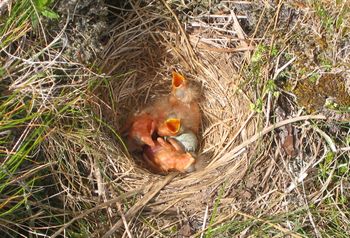
These
Redwing hatchlings are completely dependent
on parental care.
The parental behavior most closely associated with
monogamy is male
incubation. Interestingly, male incubation is the most
confining male parental behavior. It takes time and also may
require physiological changes that interfere with continued
mating. This extreme loss of mating opportunities leads to a
reduction in reproductive success among incubating males.
"This information then suggests that sexual selection may be
less intense in taxa where males incubate, hypothetically
because males allocate more effort to parental care and less
to mating"
[4]. In other words, in
bird species in which male incubation is common, females
tend to select mates on the basis of parental behaviors
rather than physical appearance.
Birds and humans
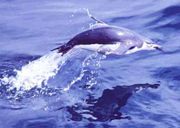
Chinstrap Penguin, Pygoscelis antarctica
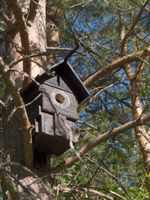
A
birdbox is an artificial platform for birds
to make a nest
Birds are an important food source for
humans. The most commonly eaten species is the domestic
chicken and its
eggs, although
geese,
pheasants,
turkeys, and
ducks are also widely eaten. Other birds that have been
utilized for food include
emus,
ostriches,
pigeons,
grouse,
quails,
doves,
woodcocks,
songbirds, and others, including small
passerines such as
finches. Birds grown for human consumption are referred
to as
poultry.
At one time
swans and
flamingos were delicacies of the rich and powerful,
although these are generally protected now.
Besides meat and eggs, birds provide other items useful
to humans, including
feathers for bedding and decoration, guano-derived
phosphorus and nitrogen used in fertilizer and gunpowder,
and the central ingredient of bird's nest soup.
Many species have become extinct through over-hunting,
such as the Passenger Pigeon, and many others have become
endangered or extinct through habitat destruction,
deforestation and intensive agriculture being common causes for declines.
Numerous species have come to depend on human activities
for food and are widespread to the point of being pests. For
example, the common pigeon or
Rock Pigeon (Columba livia) thrives in urban
areas around the world. In North America, introduced
House Sparrows, European Starlings, and House Finches are similarly widespread.
Other birds have long been used by humans to perform
tasks. For example,
homing pigeons were used to carry messages before the
advent of modern instant communications methods (many are
still kept for sport).
Falcons are still used for hunting, while
cormorants are employed by fishermen.
Chickens and
pigeons are popular as experimental subjects, and are
often used in biology and comparative psychology research. As birds are very
sensitive to toxins, the
Canary was used in
coal mines to indicate the presence of poisonous gases,
allowing miners sufficient time to escape without injury.
Colorful, particularly tropical, birds (e.g. parrots, and
mynas) are often kept as pets although this practice has led
to the illegal trafficking of some endangered species;
CITES, an international agreement adopted in 1963, has
considerably reduced trafficking in the bird species it
protects.
Bird diseases that can be contracted by humans include
psittacosis, salmonellosis, campylobacteriosis, Newcastle's
disease, mycobacteriosis (avian tuberculosis), avian
influenza, giardiasis, and cryptosporidiosis.
Threats to birds
According to Worldwatch Institute, bird populations are
declining worldwide, with 1,200 species facing extinction in
the next century.
[5] Among the biggest
cited reasons are habitat loss,[6]
predation by nonnative species,[7]
oil spills and pesticide use, hunting and fishing, and
climate change.
Trivia
- To preen or groom their feathers, birds use their
bills to brush away foreign particles.
- The birds of a region are called the
avifauna.
- Few birds use chemical defences against predators.
Tubenoses can eject an unpleasant oil against an
aggressor, and some species of pitohui, found in New
Guinea, secrete a powerful neurotoxin in their skin and feathers.
- The
Latin word for bird is avis.
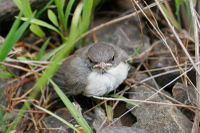
Fledgling
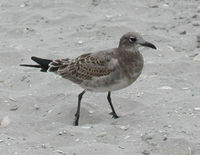
A juvenile
Laughing Gull
Bird families and
taxonomic discussion are given in
list of birds and
Sibley-Ahlquist taxonomy.
References
- ^
Early Adaptive Radiation of Birds: Evidence from Fossils
from Northeastern China -- Hou et al. 274 (5290): 1164
-- Science. Retrieved on
2006-07-21.
- ^
Education - Senior 1. Manitoba Fisheries Sustainable
Development. Retrieved on
2006-10-09.
- ^
Gowaty, Patricia Adair
(1983). Male Parental Care and Apparent Monogamy among
Eastern Bluebirds (Sialia sialis). The
American Naturalist 121 (2): 149-160.
- ^
Ketterson, Ellen D.,
and Nolan, Val (1994). Male Parental Behavior in Birds.
Annual Review of Ecology and Systematics 25:
601-28.
- ^
Worldwatch Paper #165: Winged Messengers: The Decline of
Birds. Retrieved on
2006-07-21.
- ^
Help Migratory Birds Reach Their Destinations.
Retrieved on
2006-07-21.
- ^
Protect Backyard Birds and Wildlife: Keep Pet Cats
Indoors. Retrieved on 2006-07-21.
External links




